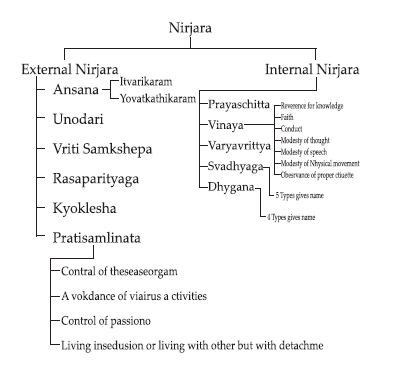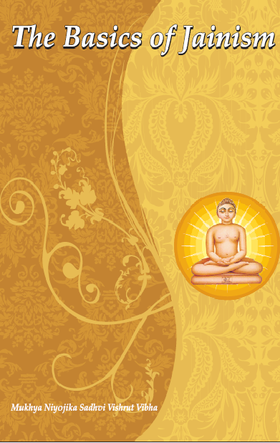The theories of Jain philosophy can be classified under two headings: those concerning the six substances and those concerning the nine categories. Though the nine categories are included in the six substances and vice versa, there is a fundamental difference between the two. The theories of the six substances explain the metaphysical structure of the cosmos whereas the nine principles delineate the path of spirituality. This topic is concerned with the nine categories. Among the nine categories, the seventh is called nirjara. Nirjara denotes the process of purification of the soul through the separation of karmic matter from the soul by the means of penance. Nirjara is of two kinds:
- Sakama Nirjara (voluntary)
- Akama Nirjara (involuntary)
The shedding of karmas with the specific aim of emancipation is called sakama nirjara, while the automatic eradication of karma particles through their maturation is known as akama nirjara. The latter is unmotivated and effortless, whereas the former is motivated and requires effort on the part of the Jiva. When a person meditates or fasts (which are various forms of penance) with the sole aim of eliminating karma, the nirjara that takes place is sakama.
As penance leads to nirjara, it is essential to understand its various kinds. There are twelve forms of penance: six external and six internal.
External Penance:
- Anasana (fasting):
Anasana means the giving up of fourfold eatables viz. 1) cereals, lentils, fruits and vegetables etc; 2) water, soft drinks etc; 3) dry fruits and 4) mouth fresheners. This is of two kinds:
- Itvarikam (short-term fasting)- fasts which last for a short duration, from one day up to six months.
- Yavatkathikam (life-long fasting)- fasts which are undertaken unto death.
- Unodari (semi-fasting):
Unodari implies reduction in the consumption of food, the use of clothes, the use of utensils and the suppression of passions (anger and the like). This penance may be practiced by curtailing one's basic necessities.
- Vriti Samkshepa (conditional acceptance of alms):
Vriti samkshepa signifies the restraint on the acceptance of alms by self-imposed restrictions. It can be observed in the context of dravya (the number of foods), kshetra (place), kala (time) and bhava (mode). For example, by limiting the dravya (the number of different kinds of foods); or a monk may restrict himself to obtaining his meals from a limited area (kshetra); or one can place restriction on when a meal may be taken (once a day or not before noon etc) and lastly, one may place conditions on oneself like only accepting food from a donor sitting or standing in a certain position.
- Rasaparityaga (abstinence from delicious foods):
Renunciation from delicious dishes such as sweets, fried foods, butter, oil etc. is known as rasaparityaga. Certain foods trigger the emotional impulses, so one should renounce them. One should eat only for the sake of sustaining life and not for taste. Also, one should concentrat on suppressing one's attachment to food.
- Kyaklesha (austerity):
Although this literally means "bodily torture", it really means to undertake postures such as kayotsarg, virasana, utkatukasana etc. The practice of special postures (asana) helps one to attain steadiness of mind, body and speech.
- Pratisamlinata (seclusion):
Pratisamlinata is the process of harmonizing the soul with itself by withdrawing the sense organs and the like from the external objects. It involves four aspects:
- Control of the sense organs
- Avoidance of vicious activities and the performance of virtuous ones.
- Control of passions
- Living in seclusion or living with others but with detachment
The above six penances are external, preliminary and preparatory means of emancipation. These penances help an individual to conquer the senses, attain firmness and control and disintegrate karma from the soul. The practice of external austerities leads to a life of detachment and purification of the soul. They influence the gross body and are also essential for internal penance. Control over the diet is the most fundamental penance, as without the control of meals, one cannot reach one's goal. Purity of diet or food is necessary for purity of behaviour.
Internal Penance:
- Prayaschitta (atonement):
Prayaschitta is a practice of atonement to purify the soul. A person commits a mistake on account of negligence or lapse of attentiveness, but then repents for his wrongdoing from the core of his heart and goes to his acharya or the head of the group to admit his wrong action and requests for punishment to cleanse his soul. Prayaschitta includes self-criticism and repentance in order to avoid repeating one's mistake.
- Vinaya (reverence):
Vinaya consists in imparting profound respect to one's superiors. It is of seven kinds:
a) Reverence for knowledge; b) Faith; c) Conduct; d) Modesty of thought; e) Modesty of speech; f) Modesty of physical movement; g) Observance of proper etiquette.These are small but powerful acts of respectful behaviour. Each one of these activities develops the virtue of politeness and destroys pride. It is helpful in the shedding of karma.
- Vaiyavrittya (service):
Vaiyavrittya consists of service, both aid and relief, to those who are leading a life of self-restraint. There are ten categories of Vaiyavrittya depending on to whom the service is given: the Acharya (pontiff), the Upadhaya (preceptor), a Sthavir (senior), a Tapasvi (practitioner of penance), a sick monk or nun, a novice, kula (a group of monks), gana (a commune of monks), sangh (the religious order). In the Jain tradition, great importance is given to Vaiyavrittya. It is written that one who serves a sick monk, serves the Tirthankars themselves.
- Svadhyaya (spiritual study):
Svadhyaya means to study the religious scriptures. Svadhyaya is of five types:
- Vachana: the teachings of scriptures and their meaning.
- Pracchana: enquiry into words requiring clarification.
- Parivartana: recitation of a memorized text.
- Anupreksha: contemplation of a text and its meaning.
- Dharmopadesha: preaching to disciples through various anuyogas (discussions).
Just as nutrition is necessary for the development of the body, Svadhyaya is essential for the development of the mind and the soul. It is a powerful means of annihilating accumulated karma.
- Dhyana (concentration or meditation):
Dhyana means concentration of one's mind on oneself or on a particular object, or it can refer to the cessation of activities of the mind, body, and speech. Dhyana has been classified into four types two of which are inauspicious and two auspicious:
- Artta dhyana (concentration due to anguish): Artta dhyana is concentration for the attainment of covetable objects of the senses such as pleasant sounds, mages, tastes etc.
- Raudra dhyana (concentration due to anger): Raudra dhyana is concentration of the mind for the purpose of perpetuating violence, falsehood, stealing for the preservation of worldly things or for sensual indulgence.
- Dharmya dhyana: Dharmya dhyana is the concentration of the conscious mind on the nature of reality or on spiritual upliftment. It is of four types:
- Agya scriptural relevation, the teaching of the omniscients
- Apaya (passions) the cause of the rise or cessation of passions
- Vipak (fruition) the results of karma
- Sansthana the forms or configuration of substances, the universe and the entire range of modes.
- Shukla dhyana: Shukla dhyana is the pure concentration of the mind.
The first two dhyana are to be abandoned by a monk while the third and the fourth dhyana are prescribed for a monk. Meditation is regarded as occupying the supreme place in the realm of nirjara. The person who meditates on the soul and detaches all his thoughts from the external world entirely, casts off all karmic matter.
- Vyutsarga (abandonment):
Vyutsarga means the giving up or detaching oneself from the body and passions. It may be giving up material objects or overcoming inner passions. The external vyutsarga pertains to four things the body, the commune of monks, and food and drink. The spiritual vyutsarga relates to three things giving up of passions, worldly life and karma.
The internal six penances are so-called because they are directly related to the soul and are essential means of attaining spiritual emancipation. The goal in performing these austerities is to train a monk and nun for a life of contemplation and meditation. The internal penances ultimately bring about total emancipation of the soul.

